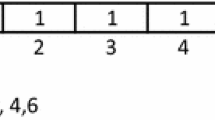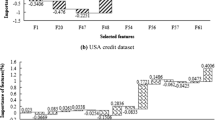Abstract
Over the past few decades, many classifier methods are suggested for credit risk evaluation. With ever-increasing amounts of data, for multi-criteria optimization classifier (MCOC) and other traditional classification methods, owing to the correlation among different features in data these classifiers often give the poor predictive performance. Thus, some dimensionality reduction techniques are firstly used to find important features; then, these classifier models are built on the reduced data set. However, because feature selection and classification are carried out in different feature spaces, the purpose of increasing predictive accuracy and interpretability is difficult to achieve truly. It is therefore important to research the new classifier methods with simultaneous classification and feature selection so as to improve the predictive accuracy and obtain the interpretable results. In this paper, we propose a novel sparse multi-criteria optimization classifier (SMCOC) based on one-norm regularization, linear and nonlinear programming, respectively, and construct the corresponding algorithm. The experimental results of credit risk evaluation and the comparison with linear and quadratic MCOCs, logistic regression and support vector machines have shown that the proposed SMCOC can enhance the separation of different credit applicants, the efficiency of credit scoring, the interpretability of risk evaluation model and the generalization power of risk prediction for new credit applicants.



Similar content being viewed by others
References
Alpaydin E (2010) Introduction to machine learning, 2nd edn. MIT Press, London
Baesens B, Egmont-Petersen M, Castelo R, Vanthienen J (2002) Learning Bayesian network classifiers for credit scoring using markov chain Monte Carlo search. In: 16th international conference on pattern recognition (ICPR’02), vol 3, pp 49–52
Bastos J (2008) Credit scoring with boosted decision trees. Online at http://mpra.ub.uni-muenchen.de/8034/ MPRA Paper No. 8034
Bekhet HA, Eletter SFK (2014) Credit risk assessment model for Jordanian commercial banks: neural scoring approach. Rev Dev Finance 4(1):20–28
Bellotti T, Crook J (2009) Support vector machines for credit scoring and discovery of significant features. Expert Syst Appl 36(2):3302–3308
Bolton C (2009) Logistic regression and its application in credit scoring. Dissertation, University of Pretoria
Capotorti A, Barbanera E (2012) Credit scoring analysis using a fuzzy probabilistic rough set model. Comput Stat Data Anal 56(4):981–994
Chen R, Zhang Z, Wu D, Zhang P, Zhang X, Wang Y, Shi Y (2011) Prediction of protein interaction hot spots using rough set-based multiple criteria linear programming. J Theor Biol 269:174–180
Cortes C, Vapnik V (1995) Support vector networks. Mach Learn 20:273–297
Cristianini N, Shawe-Taylor J (2000) An introduction to support vector machines and other kernel-based learning methods. Cambridge University Press, Cambridge
Danenas P, Garsva G (2015) Selection of support vector machines based classifiers for credit risk domain. Expert Syst Appl 42(6):3194–3204
Efron B, Hastie T, Johnstone I, Tibshirani R (2004) Least angle regression. Ann Stat 32:407–499
Fawcett T (2006) An introduction to ROC analysis. Pattern Recogn Lett 27:861–874
Freed N, Glover F (1981) Simple but powerful goal programming models for discriminant problems. Eur J Oper Res 7:44–60
Gao G, Zhang Z (2016) Prediction of Chinese word-formation patterns using the layer-weighted semantic graph-based KFP-MCO classifier. Comput Speech Lang 39:29–46
Gestel TV, Baesens B, Garcia J, Dijcke PV (2003) A support vector machine approach to credit scoring. Bank en Financiewezen 2:73–82
Glover F (1990) Improved linear programming models for discriminant analysis. Decis Sci 21:771–785
Guyon I, Elissee A (2003) An introduction to variable and feature selection. J Mach Learn Res 3:1157–1182
Hamel L (2009) Knowledge discovery with support vector machines. Wiley, Hoboken
Henley WE, Hand DJ (1996) A k-nearest-neighbor classifier for assessing consumer credit risk. Stat 1:77–95
Hosmer DW Jr, Lemeshow S, Sturdivant Rodney X (2013) Applied logistic regression. Wiley, New York
Huang C, Chen M, Wang C (2007) Credit scoring with a data mining approach based on support vector machines. Expert Syst Appl 33:847–856
Hussein AA (2009) Genetic programming for credit scoring: the case of Egyptian public sector banks. Expert Syst Appl 36(9):11402–11417
Jensen HL (1992) Using neural networks for credit scoring. Managerial Finance 18(6):15–26
Kleinbaum DG, Klein M (2010) Logistic regression: a self-learning text. Springer, New York
Lahsasna A, Ainon RN, The YW (2010) Credit scoring models using soft computing methods: a survey. Int Arab J Inf Technol 7(2):115–123
Lando D (2004) Credit risk modeling: theory and applications. Princeton University Press, Princeton
Liu H, Motoda H (2008) Computational methods of feature selection. CRC Press, Boca Raton
Liu F, Hua Z, Lim A (2015) Identifying future defaulters: a hierarchical Bayesian method. Eur J Oper Res 241(1):202–211
Marinakis Y, Marinaki M, Doumpos M, Matsatsinis N, Zopounidis C (2008) Optimization of nearest neighbor classifiers via metaheuristic algorithms for credit risk assessment. J Glob Optim 42(2):279–293
Martens D, Baesens B, Van Gestel T, Vanthienen J (2007) Comprehensible credit scoring models using rule extraction from support vector machines. Eur J Oper Res 183:1466–1476
Nebojsa N, Nevenka Z, Djordje S, Iva J (2013) The application of brute force logistic regression to corporate credit scoring models: evidence from Serbian financial statements. Expert Syst Appl 40(15):5932–5944
Ong C-S, Huang J-J, Tzeng G-H (2005) Building credit scoring models using genetic programming. Expert Syst Appl 29(1):41–47
Oreski S, Oreski G (2014) Genetic algorithm-based heuristic for feature selection in credit risk assessment. Expert Syst Appl 41(4):2052–2064
Pavlenko T, Chernyak O (2010) Credit risk modeling using Bayesian networks. Int J Intell Syst 25(4):326–344
Raymond A (2007) The credit scoring toolkit: theory and practice for retail credit risk management and decision automation. Oxford University Press, Oxford
Robert T (1996) Regression shrinkage and selection via the Lasso. J R Stat Soc Ser B 58(1):267–288
Schebesch KB, Stecking R (2005) Support vector machines for credit scoring: extension to non standard cases. In: Innovations in classification, data science, and information systems, pp 498–505
Shi Y (2010) Multiple criteria optimization based data mining methods and applications: a systematic survey. Knowl Inf Syst 24(3):369–391
Shi Y, Wise M, Luo M, Lin Y (2001) Data mining in credit card Portfolio management: a multiple criteria decision making approach. In: Koksalan M, Zionts S (eds) Advance in multiple criteria decision making in the New Millennium. Springer, Berlin, pp 427–436
Shigeo A (2010) Support vector machines for pattern classification, 2nd edn. Springer, Berlin
Sohn SY, Kim JW (2012) Decision tree-based technology credit scoring for start-up firms: Korean case. Expert Syst Appl 39(4):4007–4012
Stanczyk U, Jain LC (2015) Feature selection for data and pattern recognition. Springer, Berlin
Steven F (2010) Credit scoring, response modelling and insurance rating: a practical guide to forecasting consumer behaviour. Palgrave Macmillan, Basingstoke
Thomas LC, Crook J, Edelman D (2002) Credit scoring and its applications. Society for Industrial Mathematics, Philadelphia
Tibshirani R, Saunders M, Rosset S, Zhu J, Knight K (2005) Sparsity and smoothness via the fused lasso. J R Stat Soc Ser B 67:91–108
Vapnik VN (1998) Statistic learning theory. Wiley, New York
West D (2000) Neural network credit scoring models. Comput Oper Res 27:1131–1152
Wiginton JC (1980) A note on the comparison of logit and discriminant models of consumer credit behaviour. J Financ Quant Anal 15:757–770
Zhang Z, Shi Y, Gao G (2009) A rough set-based multiple criteria linear programming approach for the medical diagnosis and prognosis. Expert Syst Appl 36(5):8932–8937
Zhang D, Zhou X, Leung SCH, Zheng J (2010) Vertical bagging decision trees model for credit scoring. Expert Syst Appl 37(12):7838–7843
Zhang Z, Gao G, Yue J, Duan Y, Shi Y (2014a) Multi-criteria optimization classifier using fuzzification, kernel and penalty factors for predicting protein interaction hot spots. Appl Soft Comput 18:115–125
Zhang Z, Gao G, Shi Y (2014b) Credit risk evaluation using multi-criteria optimization classifier with kernel, fuzzification and penalty factors. Eur J Oper Res 237:335–348
Zhang Z, Gao G, Tian Y (2015) Multi-kernel multi-criteria optimization classifier with fuzzification and penalty factors for predicting biological activity. Knowl Based Syst 89:301–313
Zou H, Hastie T (2005) Regularization and variable selection via the elastic net. J R Stat Soc Ser B 67:301–320
Acknowledgements
The authors would like to thank the anonymous reviewers for their valuable comments and suggestions. This research has been partially supported by the Science Foundation of Ludong University (LY2010013) and the Natural Science Foundation of Shandong (ZR2012FL13, ZR2016FM15).
Author information
Authors and Affiliations
Corresponding author
Ethics declarations
Conflict of interest
The authors declare that they have no conflict of interest.
Ethical approval
The article does not contain any studies with human participants or animals performed by any of the authors.
Informed consent
Informed consent was obtained from all individual participants included in the study.
Additional information
Communicated by V. Loia.
Rights and permissions
About this article
Cite this article
Zhang, Z., He, J., Gao, G. et al. Sparse multi-criteria optimization classifier for credit risk evaluation. Soft Comput 23, 3053–3066 (2019). https://doi.org/10.1007/s00500-017-2953-4
Published:
Issue Date:
DOI: https://doi.org/10.1007/s00500-017-2953-4




